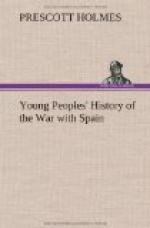“Gridley, you may fire when you are ready.”
Then the guns of the Olympia spoke, and those of the other ships followed her example. During the five times they passed and repassed the Spanish ships and forts, their courses resembled a gigantic figure 8.
Between the entrance to the bay and the city of Manila is an arm of land or promontory, pointing upwards and towards the city. It is on the right hand side of the bay and is called Cavite. The word means a fishhook, and the promontory looks something like one. Behind Cavite and in the bay of the same name, the Spanish ships were stationed, and at the little town of Cavite was an arsenal and quite a respectable navy-yard.
[Illustration: Landing the Marines at Cavite.]
When Dewey withdrew his ships to ascertain what damage the Spaniards had inflicted upon them, the Spaniards thought they had driven them off, and so they sent a dispatch from Manila to Spain saying that they had won a great victory over the Americans; but when Dewey made the second attack, after breakfast, there was not much more for him to do, for the Spaniards were well whipped. Dewey had met a foreign foe in its own waters, and added another victory to the glorious record of the navy of the United States.
[Illustration: Signaling.]
After the battle, one of the signal boys on the flagship wrote a very interesting letter to his friends at home:
“... We are all nearly wild with the effects of victory. The pride of Spain is here under our feet. No doubt before this letter reaches you, you will read full accounts of the battle—a battle that was hard fought and bloodless for the victorious. Not a man in our fleet was killed. Six men were slightly wounded on the Baltimore.
“Say, it was grand! We left Mirs Bay, in China, at two a.m., Wednesday, April 27th. Saturday afternoon we sighted Subig Bay. The Boston and the Concord were sent ahead of the fleet as scouts. We expected to find the Spanish fleet and have our first engagement. We could not find them there, so the Commodore and Captains held a council of war and decided to run past the forts at night.
“It was nine-thirty that night when we sighted the entrance. We went quietly to quarters, loaded our guns, shook hands with each other and trusted to luck. I was on signal watch on the aft bridge and could see everything. Not a sound was heard. At twelve o’clock we were under the guns of the first fort. It was an island called Corregidor. I tell you I felt uneasy. The moon was well up, but not a light could be seen.
“There were two signal officers and three other boys with me. We were laughing and joking with one another to steady our nerves. When we were well under the guns a rocket was fired, and every man braced himself. Then you could hear the breech blocks closing and the officers telling the men to aim steady and to kill.
“Well, all the ships passed that fort, but there were twenty-six miles to go yet, and God and the Spaniards alone knew how many batteries, mines and torpedoes were ready to send us all to eternity.




